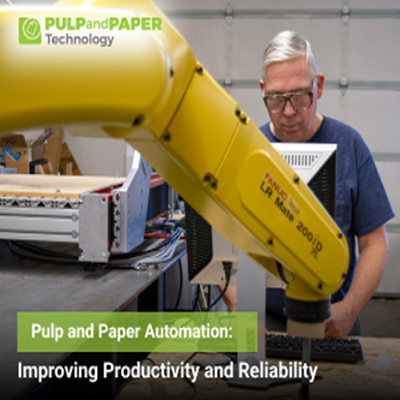Pulp and Paper Automation: Improving Productivity and Reliability

Introduction
The pulp and paper industry has come a long way from traditional manual processes to embracing cutting-edge automation technologies. In recent years, the integration of automation in pulp and paper mills has played a pivotal role in enhancing productivity and reliability. This article delves into the world of pulp and paper automation, exploring how these technological advancements are reshaping the industry landscape.
Understanding Pulp and Paper Manufacturing
Before we delve into automation, let's take a moment to understand the basics of pulp and paper manufacturing. The process involves converting raw materials like wood, recycled paper, or agricultural fibers into paper products. Traditionally, this process was labor-intensive and time-consuming, involving various manual steps.
Yet, due to technological advancements, the industry has experienced a substantial transformation. Automation has emerged as a crucial factor in streamlining operations and guaranteeing efficiency in the pulp and paper manufacturing process.
The Role of Automation in Pulp and Paper Mills
1. Process Optimization
Automation in pulp and paper mills aims to improve various production stages, from raw material preparation to final product creation. Utilizing automation technologies ensures precision and consistency throughout these processes. These automated systems are capable of controlling material flow, monitoring production parameters, and making real-time adjustments, ultimately leading to increased efficiency and reduced waste.
2. Quality Control
Maintaining product quality is crucial in the pulp and paper industry. Automation systems come equipped with advanced sensors and monitoring tools that can detect variations in raw materials and adjust processing parameters accordingly. This results in a more consistent product quality, meeting industry standards and customer expectations.
3. Energy Efficiency
The consumption of energy poses a noteworthy challenge in manufacturing industries, particularly in pulp and paper mills where diverse processes demand substantial energy. Automation systems provide enhanced control over energy usage by optimizing equipment performance and adjusting processes in response to real-time energy demand. This not only trims operational costs but also fosters a more sustainable and environmentally friendly operation.
4. Reliability and Maintenance
An essential advantage of automation in pulp and paper mills is the enhancement of reliability and maintenance. Automated systems have the capability to monitor the health of equipment in real-time, predicting potential failures before they manifest. This proactive approach reduces downtime, lessens the necessity for emergency repairs, and prolongs the lifespan of machinery. In the end, this results in heightened overall reliability and productivity.
5. Data Analytics and Decision Support
Automation systems generate a wealth of data that can be leveraged for informed decision-making. Through data analytics, operators can gain insights into production trends, identify areas for improvement, and make data-driven decisions. This not only enhances efficiency but also provides a competitive edge in the market.
Challenges and Considerations
While the benefits of pulp and paper automation are evident, the implementation of these technologies comes with its own set of challenges. One major concern is the initial investment required for upgrading or installing automation systems. Many mills may hesitate to adopt these technologies due to concerns about the associated costs.
Furthermore, a proficient workforce is essential to operate and maintain automated systems. Training programs and educational initiatives play a pivotal role in ensuring that industry professionals possess the necessary skills to adeptly navigate the intricacies of modern automation technologies.
Cybersecurity is another critical consideration. As mills become more interconnected through automation, they become susceptible to cyber threats. Robust cybersecurity measures are essential to protect sensitive data, maintain operational integrity, and prevent potential disruptions.
Case Studies: Real-World Impact of Automation
1. Voith BlueLine Stock Preparation System
Voith, a leading provider of papermaking technologies, introduced the BlueLine Stock Preparation System, an integrated solution for pulp preparation. This system incorporates automation to optimize the entire preparation process, from raw material intake to the paper machine feed.
The outcomes have been impressive, as mills have observed heightened efficiency, lowered energy consumption, and enhanced product quality. Automated controls enable precise adjustments, ensuring optimal performance across the entire production cycle.
2. ABB Ability™ Advanced Process Control for Pulp & Paper
ABB, a pioneering technology company, offers advanced process control solutions specifically tailored for the pulp and paper industry. This system utilizes artificial intelligence and machine learning algorithms to optimize production processes, improve quality, and reduce energy consumption.
Mills implementing ABB's automation solutions have experienced significant improvements in production efficiency and reliability. The ability to continuously adapt and optimize processes based on real-time data has positioned these mills at the forefront of technological innovation.
Future Trends in Pulp and Paper Automation
As technology continues to advance, the future of pulp and paper automation holds exciting possibilities. Some emerging trends include:
1. Integration of Industry 4.0 Technologies
The incorporation of Industry 4.0 technologies, including the Internet of Things (IoT) and cloud computing, is anticipated to be a central factor in the advancement of pulp and paper automation. This interconnected ecosystem will facilitate smooth communication among devices, systems, and stakeholders, fostering data-driven decision-making and further enhancing overall efficiency.
2. Artificial Intelligence and Machine Learning Applications
The implementation of machine learning (ML) and artificial intelligence (AI) in pulp and paper automation is on the verge of transforming how mills function. These technologies possess the capability to analyze large volumes of data in real-time, discern patterns, and offer predictive recommendations. Such a predictive maintenance approach holds the promise of significantly reducing downtime and enhancing equipment reliability.
3. Remote Monitoring and Control
The significance of remote monitoring and control capabilities is growing, particularly in the face of global events that could disrupt regular operations. Automation systems enabling remote monitoring and control empower mill operators to oversee production processes from any location, ensuring continuity and responsiveness to dynamic circumstances.
Conclusion
Pulp and paper automation is a game-changer for an industry that has deep-rooted traditions. The shift towards automated processes is driven by the need for increased efficiency, reliability, and sustainability. As mills continue to embrace these technologies, the benefits in terms of reduced costs, improved product quality, and enhanced competitiveness become evident.
While challenges exist, the long-term gains of implementing automation far outweigh the initial hurdles. The future of pulp and paper manufacturing is undeniably linked to the continued integration of innovative automation technologies, ensuring a more resilient and technologically advanced industry. As we move forward, it's essential for industry stakeholders to collaborate, invest in workforce development, and stay abreast of emerging technologies to unlock the full potential of pulp and paper automation.







